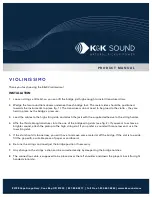
42
GB
Values acquired from soil examination
Plants tolerate high values only for a short
period of time. If the values do not change
over the long term, the soil has to be exami-
ned in order to find out what elements are
present in the wrong proportion.
Drought / waterlogging
When the soil is very dry, no value will be
displayed.
With waterlogging, the values will increase
from fivefold to tenfold reaching toxic values.
The reason behind this is colloid disintegra-
tion, i.e. the initial bonds between the ions
start disintegrating.
›
Application tips for AM measurements
Refer to the User’s Manual for more informa-
tion on connecting and measuring with the
AM probe.
Insert the AM probe in the moist soil (the
soil should always have the same moisture
content so that you can compare measure-
ments).
The entire measurement area of the probe tip
should be covered. The following probes are
available: 75 cm, 50 cm and 25 cm; area of
measurement: 3 cm, 1 cm Ø.
Repeat the measurement at least five times
at different places in order to obtain an ave-
rage value. Within a culture, slight measure-
ment fluctuations of 0.3 to 0.5 are typical.
Taking measurements in the open,
in beds and patches and in a forest
The measurements have to be taken at the
same distance from the plants, in the same
depth within the soil and in moist, but not irri-
gated soil.
Measuring loose soil and substrata
Fill moist, but not irrigated soil into a vessel,
compress it slightly and take the measure-
ment.
General recommendations
If the dirt or cultivated soil has just been
watered, you should wait some time (about
60 minutes) before taking the measure-
ment. The moisture content of the substrata
or mineral soil should remain constant so
that the measurements can be compared
We recommend always measuring with the
same soil moisture (for example, always one
hour or one day after watering has taken
place).
Various long-term fertilizers will give off most
nutrients at high temperatures; this is why the
measurement time and the soil temperature
are key factors.
›
Application tips for EC measurements
Taking water samples
Carry out water sampling (complete analysis)
only from June to August. Repeat the sam-
pling only at the same season. You also have
to consider when the well or ground water
is being used the most. The removed sample
has to be from 0.7 to 1 litre.
Remember that the measured EC value (rapid
test method) does not replace a water ana-
lysis.
Rain water offers the advantage that it is
usually good quality with low salinity and low
pH. Water from a public utility is usually of
consistent quality, but may be hard depending
on your region. Water from adjacent rivers or
lakes often has a satisfactory quality, but is
subject to fluctuations depending on rainfall
or impurities. Well water is often available in
sufficient quantity; however it is subject to
seasonal fluctuations and the quality varies
(it may be very hard).
Conversion factor:
1.4 mS/cm corresponds to 0.746 g/l salt (KCl)
EC value of the substrata or mineral soil
Carry out a substrata test while considering
the dimensional weight:
Fill the beaker with deionised water until you
reach the mark «B»; add substrata until the
mark «A» is reached. For mineral soil, deio-
nised water is filled up to mark «C» and soil is
added until the mark «A» is reached.
For substrata samples, the substrata to water
ratio is 1:5; in mineral soils, the soil to water
ratio is 1:2.
The measurement result (EC) will be given
in millisiemens per centimetre (mS/cm). One
mS/cm corresponds to 535 milligrams per litre
of KCl-salt at 25°C.
MULTI 2000
Содержание Stelzner EC 2000
Страница 27: ...29 DE...
Страница 51: ...53 GB...
Страница 109: ...111 RUS pH 6 5 7 0 pH 2 2 pH pH pH pH pH H2O pH pH pH KCl 1 pH KCl pH H2O 1 pH H20 pH KCl pH KCl pH H2O AGRAR 2000...
Страница 118: ...120 RUS 5 10 AM AM 75 50 25 3 1 5 0 3 0 5 60 pH Primula acaulis MULTI 2000 AM MULTI 2000 MULTI 2000...
Страница 119: ...121 RUS EC 0 7 1 EC pH 1 4 0 746 KCl EC B A C 1 5 1 2 EC 535 KCl 25 C pH pH pH 50 1 5 1 2 CaCl2 0 01 CaCl2 10 MULTI 2000...
Страница 120: ...122 RUS pH pH pH 6 0 4 pH pH MODE 145 45 59 4 2 MULTI 2000 0 1 MULTI 2000...
Страница 153: ...155...
Страница 155: ...157...
Страница 156: ......
Страница 157: ......
Страница 158: ......
















































